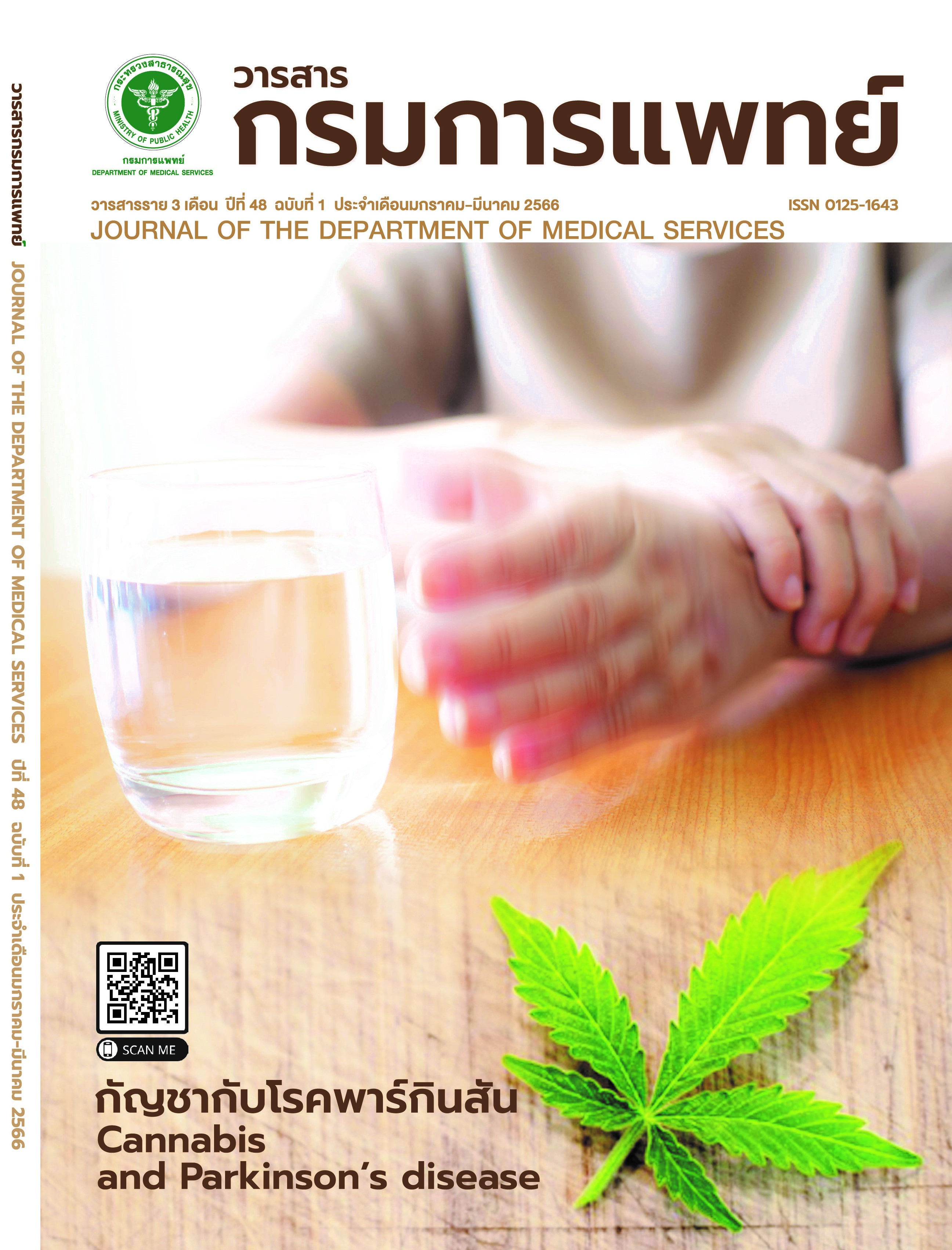Antiretroviral Resistance and Gene Mutations in Patients with High Blood Levels of HIV in Lampang Hospital during the Year 2020-2021
Keywords:
Antiretroviral drug, gene mutation, drug resistanceAbstract
Background: HIV patients need antiretroviral therapy, which can inhibit the proliferation of the virus, fortreatment. However, inconsistent medication use or the widespread use of antiviral medications can lead to antiviralresistance. Objective: To determine the rate of HIV drug resistance and gene mutation that causes antiretroviralresistance in patients at Lampang Hospital. Methods: Retrospective study were collected for antiretroviral drugresistance testing from 1 January 2020 to 31 December 2021 from 477 patients with HIV viral load greater than1,000 copies/ml. 108 cases were considered by physician for antiretroviral drug resistance testing and collecteddata on mutated gene testing. Results: From 108 patients tested for antiretroviral drug resistance, 83 were foundto be resistant to antiretroviral drugs in the nucleoside reverse transcriptase inhibitors (NRTIs), non- nucleosidereverse transcriptase inhibitors (NNRTIs) and protease inhibitors (PIs) groups. 67 patients were tested for genemutations of NRTIs gene. It was found that the most mutated position was M184V, which was found in 40patients, followed by D67N in 22 patients. The rate of resistance to Emtricitabine and Lamivudine was 51 casesfor each mutated position. For NNRTIs gene mutation test, the most mutated position was K103N, which wasfound in 29 patients, followed by Y181C in 20 patients. 61 cases were found to be resistant to Efavirenz, and60 for Navirapine. As for the Pls group, the mutation position was M46I, which was found in 3 patients. 2 caseswere found to be resistant to Indinavir. However, this study found that there was no drug resistance in integrasestrand transfer inhibitors (INSTIs). Conclusions: Patients with high blood levels of HIV in Lampang Hospital showeddrug resistance in NRTIs, NNRTIs and PIs, with the most concomitant drug resistance among NRTIs+ NNRTIs. No drugresistance was found in INSTIs.
References
WHO HIV/AIDS. [Internet] 2022. [cited 2022 Mar 26]. Availablefrom https://www.who. int/news-room/fact-sheets/detail/hiv-aids.
Thailand National Guidelines on HIV/AIDS Treatment andPrevention 2020/2021. [Internet] 2020. [cited 2022 Mar26]. Available from: https://ddc.moph.go.th/uploads/publish/1138820210507024312.pdf
HIV drug resistance. [Internet] 2022 [cited 2022 Mar 26].Available from: https://www.who. int/teams/global-hivhepatitis-and-stis-programmes/hiv/treatment/hiv-drugresistance.
HIV antiretrovirus drug resistance. [Internet] 2017. [cited 2022Mar 26]. Available from https://ccpe.pharmacycouncil.org/index.php?option=article_detail&subpage=article_detail&id=255
HIV drug resistance. [Internet] 2022 [cited 2022 Aug 21].Available from https://www.who. int/news-room/fact-sheets/detail/hiv-drug-resistance.
Bureau of Epidemiology, Department of Disease Control. thesituation HIV-infected, Thailand, 2017. Development Group AIDSEpidemiological Surveillance System; 2018.
Understanding HIV/AIDS Glossary Drug class 2017. [internet][cited 2022 Feb 25] Available from: https://clinicalinfo.hiv.gov/en/glossary/drug-class.
FDA-approved HIV medicines 2017 [internet] [cited 2022 Feb 25]Available from: https:// aidsinfo.nih.gov/understanding-hiv-aids/fact-sheets/19/58/fda approved-hiv-medicines.
Vila Operations Singapore. Sentosa test kit ®SQ HIV-1 GenotypingAssay v2.0 (4X24).7 [internet] [cited 2022 Mar 20] Available from:https://www.veladx.com/.
Jinasen R. Situation of HIV Infection and ARV Treatment inHIV Infection/AIDS Patient Analysis in Chiangrai PrachanukrohHospital, Chiangrai Province. Thai AIDS J 2018; 30: 57–68.
Kohreanudom S. Surveillance of drug-resistant HIV epidemic inThailand 2010. Journal of Disease Control 2011; 37: 243-252.
Treeboonmuang P, Putthanachote N. Drug Resistance Testing ofHIV Patients/Aids Antiviral HIV Drugs Treatment at Roi Et Hospital:A Retrospective Study. Health Science Journal of Thailand 2021;3:10-16.
Ammassari AA, Starace F, Aloisi MS, Trotta MP, Murri R, D’ArminioMonforte A, et al. Medication adherence among HIV+ adults:effects of cognitive dysfunction and regimen complexity.Neurology. 2003; 61:723-4
Achappa B, Madi D, Bhaskaran U, Ramapuram JT, Rao S,Mahalingam S. Adherence to Antiretroviral Therapy AmongPeople Living with HIV. N Am J Med Sci. 2013; 5:220-3.
Phadungpattanodom J. The situation of JIV-1 antiretroviral drugsresistance in Pranangklao Hospital. Journal of Medical and PublicHealth Region 4 2020; 10:48-57.
Khaolaor S. Prevalence and associated factors of antiviral drugresistance in HIV patients treated with antiretroviral therapy ina longterm HIV-infected Thai cohort: HIV-NAT, Thai Red CrossAids Research center. [internet] 2010. [cited 2022]. Availablefrom: http://cuir.car. chula.ac.th/handle/123456789/32397.
Update of recommendations on frst- and second-lineantiretroviral regimens. [Internet] 2019 [cited 2022 Aug 24].Available from: https://apps.who.int/iris/bitstream/handle/10665/ 325892/WHO-CDS-HIV-19.15-eng.pdf?ua=1&fbclid=IwAR2gz6wyTZQrIKpBVe5tTqvg5Xy0DlhvnWkIds1nxhbVhlmboJXkZrC-Upg
Guideline for the use antiretroviral agents in HIV-1 infectedadults and adolescents. [internet] 2008 [cited 2022]. Availablefrom: https://www.go2itech.org/HTML/CM08/toolkit/ links/print/Clinical/DHHS_Adult_Adolescent_GL.pdf
van Eijken M, Tsang S, Wensing M, de Smet PA, Grol RP.Interventions to improve medication compliance in olderpatients living in the community: a systematic review of theliterature. Drugs Aging. 2003; 20:229-40.
Downloads
Published
How to Cite
Issue
Section
License
Copyright (c) 2023 Department of Medical Services, Ministry of Public Health

This work is licensed under a Creative Commons Attribution-NonCommercial-NoDerivatives 4.0 International License.
บทความที่ได้รับการตีพิมพ์เป็นลิขสิทธิ์ของกรมการแพทย์ กระทรวงสาธารณสุข
ข้อความและข้อคิดเห็นต่างๆ เป็นของผู้เขียนบทความ ไม่ใช่ความเห็นของกองบรรณาธิการหรือของวารสารกรมการแพทย์



